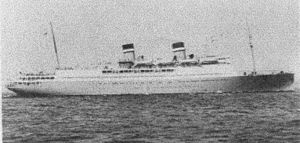USAT Thomas H. Barry

USAT Thomas H. Barry, formerly SS Oriente, off Norfolk, VA
|
|
| History | |
|---|---|
|
|
|
| Name: |
SS Oriente (1930–41) USAT Thomas H. Barry (1941–57) |
| Namesake: |
Oriente Province, Cuba US Army General Thomas H. Barry |
| Owner: | Agwi Navigation Co, Inc |
| Operator: |
|
| Port of registry: | New York |
| Builder: | Newport News Shipbuilding |
| Launched: | 15 May 1930 |
| Completed: | 1930 |
| Acquired: | for the US Army: June 1941 |
| In service: | 1930 |
| Out of service: | 1949 |
| Renamed: | Thomas H. Barry, June 1941 |
| Reclassified: | AP-45 (Never effective) |
| Homeport: | New York |
| Identification: |
|
| Fate: | laid up in the National Defense Reserve Fleet 1950; scrapped 1957 |
| Status: | scrapped 1957 |
| General characteristics | |
| Type: | ocean liner, then troopship |
| Tonnage: | |
| Length: | 508 ft (155 m) |
| Beam: | 70.9 ft (21.6 m) |
| Draft: | 27 feet 3 inches (8.31 m) |
| Depth: | 39.0 ft (11.9 m) |
| Propulsion: | steam turbo-electric transmission, twin screws |
| Speed: | 18 knots (33 km/h) |
| Troops: | 3,609 |
| Complement: | 50 |
| Armament: |
|
| Notes: | sister ship: SS Morro Castle |
SS Oriente (1930–41)
Oriente Province, Cuba
USAT Thomas H. Barry, formerly SS Oriente, was a Ward Line ocean liner that became a United States Army troopship in the Second World War. She was intended for transfer to the United States Navy and assigned the hull number AP-45, but was not transferred and remained with the Army.
Newport News Shipbuilding and Drydock Company built Oriente for Ward Line as a sister ship to SS Morro Castle. Oriente was completed in 1930, two months after Morro Castle. Each ship was 508 feet (155 metres) long, measured 11,520 gross register tons (GRT) and had turbo-electric transmission, with General Electric twin turbo generators supplying current to propulsion motors on twin propeller shafts. The two liners carried passengers between New York and Havana, Cuba.
In 1934 a fire destroyed Morro Castle, killing 135 people. Oriente remained in Ward Line service until 1941.
Oriente was among the ships designated for Army among the twenty-eight merchant vessels (twenty-one for the Navy and seven to the Army) requisitioned by the Maritime Commission's Division of Emergency Shipping announced on 4 June 1941. The ship was purchased and delivered to the US War Department on 14 June 1941 and renamed USAT Thomas H. Barry designated as a troopship. The ship was one of the relatively few transports owned, rather than bareboat chartered, by the Army.
Thomas H. Barry was one of seven transports hurriedly assembled in New York and sailing late on 22 January 1941 (23 January GMT) in what was then the largest troop movement attempted, movement of POPPY FORCE, also designated Task Force 6814, under General Alexander Patch to secure New Caledonia (codename POPPY) on the vital South Pacific link to Australia. The seven ships had a troop capacity of almost 22,000. Task Force 6814 was later organized in New Caledonia as the Americal Division.
...
Wikipedia
